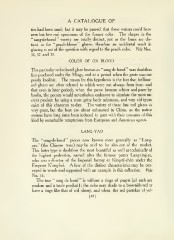Page 126 - Chinese porcelains collected by Mr. and Mrs. Charles P. Taft, Cincinnati, Ohio, by John Getz
P. 126
A CATALOGUE OF
ties had been used; but it may be proved that these writers could have
seen but few real specimens of the former color. The shapes in the
" sang-de-boeuf " variety are totally distinct, just as the forms are dis-
tinct in the "peach-bloom" glazes; therefore an accidental result in
glazing is out of the question with regard to the peach color. Vide Nos.
36. 37, and 38.
COLOR OF OX BLOOD
The particular red-colored glaze knowTi as "sang de bceuf" was doubtless
first produced under the Mings, and at a period when the paste was not
purely kaolinic. The reason for this hypothesis is the fact that brilliant-
red glazes are often referred to which were not always from iron; and
that even in later periods, when the paste became whiter and purer by
kaolin, the potters would nevertheless endeavor to simulate the more an-
cient product by using a more gritty body substance, and very old types
exist of this character to-day. The variety of these fine red glazes is
very great, but the best are about exhausted in China, as the native
owners have long since been induced to part with their treasures of this
kind by remarkable temptations from European and American agents.
LANG-YAO
The "sang-de-boeuf" pieces now knowm more generally as "Lang-
yao" (the Chinese term) may be said to be also out of the market.
This latter type is doubtless the most beautiful as well as technically of
the highest perfection, named after the famous potter Lang-ting-so,
who was a director of the Imperial factory at King-te-chen under the
AEmperor K'ang-hsi. few of the distinct characteristics may be con-
veyed in words and supported with an example in this collection. Vide
No. 35.
The true " sang de boeuf " is without a tinge of purple (all such are
modem and a trade product) ; the color may shade to a brownish-red or
have a tinge like that of old sherry, and when the red partakes of yel-
[40]

